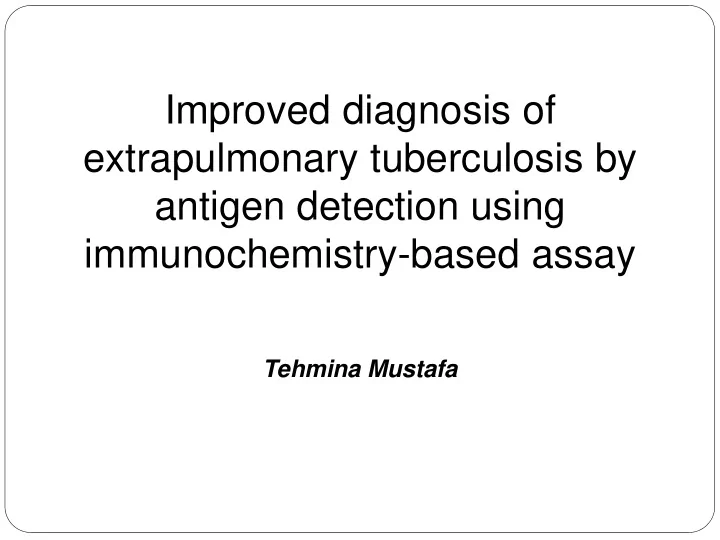

Improved diagnosis of extrapulmonary tuberculosis by antigen detection using immunochemistry-based assay Tehmina Mustafa
Overview • Introduction: extrapulmonary tuberculosis (TB) & diagnostic challenges • New diagnostic method – Biopsies – Fluids • Further research plans
Burden & distribution of extrapulmonary TB Both, 9% Extrapulmonary, 20% Pleural, 18% Lymphatic, 42% Other, 13% Pulmonary, 71% Bone/joint, 11% Genitourinary, 5% Meningeal, 5% Peritoneal, 6% Source: United States, CDC, 2008
Burden of extrapulmonary TB (2) • HIV-TB co-nfection- > 50% extrapulmonary • Pediatric TB – higher proportion extrapulmonary
Is extrapulmonary TB infectious? EPTB /sputum neg TB accounts for 13% of TB transmission (Tostmann, 2008) Transmission from genitourinary TB ( D’ Agata, 2001)
Diagnostic challenges EPTB • Clinical criteria without lab: over-diagnosis (~25%) • Acid-fast stain/microscopy: detection limit 10000 bacilli/ml • Culture: detection limit 100 bacilli/ml • Histology/cytology – differentiation from other granulomatous diseases – atypical histological with HIV coinfection • PCR based methods: better sensitivity, expensive, PCR machine, sensitive to contamination • Serology: not recommended
Immunohistochemistry & immunocytochemistry • Immunochemistry - more sensitive than acid fast staining- intact bacillary cell-wall is not a prerequisite. • Potential to distinguish between different mycobacterial species. • Limited studies for use as a diagnostic test probably due to non- availability of specific antibodies for M.tuberculosis antigens
MPT64 antigen • In-house rabbit polyclonal antibody for detection of MPT64 antigen: 26-kDa secreted mycobacterial protein – specific for the M.tuberculosis complex – Distinguish pathogenic from atypical mycobacteria.
Material • Extrapulmonary TB • Lymph nodes • Pleura • Abdomen • CNS • Tissue biopsies- pleura, lymph nodes, abdominal TB • Cell smears-pleural fluid, ascitic fluid, CSF & lymph node aspirates
Diagnostic procedures – Acid-fast staing – Culture (LJ medium) – Immunohistochemistry/immunocytochemistry – PCR for IS6110 (specific for M.tuberculosis complex)
Positive results of diagnostic procedure in TB and non-TB biopsies
Val alidity ity of MP MPT6 T64-IHC IHC as as diag agnosti nostic c test • PCR for IS6110 (specific for M.tuberculosis complex) was used as “gold standard” Tissues Sensitivity Specificity LYMPH GLAND Norway (n=32) 95 62 Tanzania (n=35) 88 90 India (n=152 ) 93 98 ABDOMINAL TB 89 95 India (n=51) Pleura 72 61 (HIV-coinfection) (80) (100) South Africa (n=36)
M.tuberculosis specific protein MPT64 in TB lymph nodes MPT64 10x 10x 40x
M.tuberculosis specific protein MPT64 in TB lymph nodes
M.tuberculosis specific protein MPT64 antigen in abdominal TB lesions Intestinal wall Peritoneum
Mycobacterial MPT64 antigen in HIV-TB coinfected pleural TB lesions Granulomatous inflammation, n=14 MPT64
Mycobacterial MPT64 antigen in HIV-TB coinfected pleural TB lesions- atypical histology Acid-fast stain H&E stain IHC-MPT64 IHC- MPT64
Positive results of various diagnostic procedures on fluids & aspirate
Immunocytochemical staining of mycobacterial antigen MPT64 CSF Pleural fluid B LN Ascitic Aspirate fluid D
Validation of Immun unocyt ocytoche ochemis mistr try y Nested-PCR used as gold standard Sensitivity = 96% Specificity = 96%
Conclusion Immunochemistry with a-MPT64 is: rapid, sensitive and specific method for establishing etiological diagnosis of TB unlike PCR, not sensitive to contamination, does not require sofisticated equipment, can be established in a pathology/cytology lab.
Further Research To assess the feasibility of implementation and validity of the assay in the routine diagnostic settings To assess improvement in case detection comparing the intervention and control hospitals. To improve the diagnostic capacity and sustain the quality at the TB diagnostic laboratories in low-income settings by training and academic building of the staff. Cost-effectiveness analysis of the assay after implementation at selected hospitals for future scale-up.
A hospital implementing WHO endorsed DOTS strategy and a pathology laboratory will be selected from each of the 5 sites; Tanzania, Zanzibar, India, Pakistan,and Norway. 1-3 control from each site (except Norway)
Recommend
More recommend